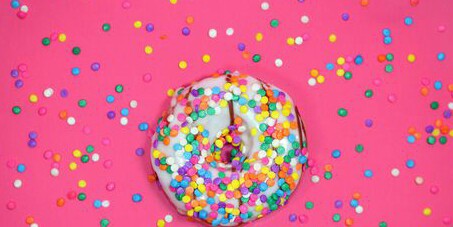News
15 Foods You Should Avoid If You Have Diabetes

These foods spell disaster for your blood sugar.
By Markham Heid And Alisa Hrustic Sep 4, 2018

For those who don’t have diabetes , nibbling a cookie here or some French fries there isn’t a big deal. Those unhealthy treats may run counter to your diet or weight loss goals, but eating them isn’t the end of the world. For people with diabetes, on the other hand, one too many slip-ups could carry potentially life-threatening consequences.
“It’s hard to say exactly what’s okay and what’s not because every patient with diabetes is a little different, and every patient’s tolerance for carbohydrates is different,” says Matthew Freeby, MD, director of the Gonda Diabetes Center at UCLA Health . “But if a patient eats enough carbohydrates that the pancreas is unable to produce insulin to drive blood sugar down, that’s what we worry about.”
6 Weird Things That Might Cause Diabetes
Carbohydrates—a macronutrient group that includes sugar—pose the greatest threat to people with diabetes. Foods heavy in protein and fat, on the other hand, “tend to be the ones we have patients gravitate toward,” he explains.
Too-high or too-low blood sugar levels—known as hyperglycemia and hypoglycemia, respectively—can lead to symptoms like nausea , vomiting, stomach pain, a rapid heartbeat, dizziness, or confusion. Experiencing any of these symptoms when you have diabetes should send you to the doc ASAP. In extreme cases, high or low blood sugar could lead to unconsciousness and death.
“No food needs to be completed banned from your diet,” explains Vandana Sheth, RD, certified diabetes educator and spokesperson for the Academy of Nutrition and Dietetics. “However, some foods make it easier to manage your diabetes compared to others. A registered dietitian nutritionist specializing in diabetes can help you enjoy your favorite foods while also maintaining good blood sugar control.”
So which foods are most likely to get people with diabetes into trouble? Keep reading.
Soda
While there’s a small mountain of evidence linking diet soda to larger waistlines and other health concerns, regular soda is a much greater threat to those with diabetes. “When patients ask about what they should avoid, one of the top things I recommend are sugar-sweetened beverages,” says Angela Ginn-Meadow, a registered dietician and certified diabetes educator with the University of Maryland’s Center for Diabetes and Endocrinology.
A single 12-ounce can of Coca Cola contains 39 grams of sugar . To put that in perspective, the
American Heart Association recommends that adult women should cap their total daily sugar intake at 25 grams, while men should go no higher than 36 grams.
Also, because a liquid can be consumed much more quickly than most foods, pounding a large glass of soda is one of the easiest ways to overload your system and send your blood sugar levels soaring. Sports drinks and bottled teas are also major sources of sugar.
Fruit juice
“As much as we think of fruit juice as healthy, they are primarily sugar,” Ginn-Meadow says. And for diabetics—and the rest of us, actually—there doesn’t seem to be a big difference between consuming sugar in the form of soda or in the form of fruit juice. Both are unhealthy , research shows.
If that surprises you, consider that 12 ounces of two popular store-bought orange juices—
Tropicana and Florida’s Natural —contain 33 grams of sugar. Fresh squeezed, unpasteurized OJ isn’t any less sugar-rich, according to USDA nutrient estimates .
Donuts and bagels
“Many of my patients with diabetes think about sugar as being the worst thing that’s impacting their blood sugar, but it’s really about carbohydrates,” Dr. Freeby says. “I tell them to look at nutrition labels for the total carbohydrate content, not just the sugar content.” Donuts and bagels made with refined and processed grains are major sources of blood-sugar-spiking carbs, he says.
For example: One plain “old fashioned” donut from Dunkin Donuts contains 28g of carbohydrates—the same amount found in 8.5 ounces of Coca Cola. One Dunkin Donut maple vanilla crème donut? You don’t want to know. (Except you do, right? It packs 43g of carbs.) Maybe most surprising, one plain Einstein Bros. bagel contains 56g carbs.
French fries
Dr. Freeby says that “starchy” vegetables like potatoes and corn are major sources of carbohydrates, and so need to be eaten sparingly or avoided.
Turn potatoes into French fries, and the health risks are often compounded. Medium-sized fries from McDonald’s contain 44g carbs. A medium fry at Wendy’s? You’re dropping 56g of carbs into your system.
“If you want to incorporate potatoes, you are better off enjoying a small-medium baked potato with the skin on,” says Sheth. “You could also swap out and enjoy oven roasted veggies such as cauliflower, broccoli, peppers instead to increase your veggie intake and minimize a spike in your blood sugar.”
…or any deep fried foods, for that matter
GETTY IMAGES / DEBBISMIRNOFF
Frying any type of food ultimately changes its composition, according to a study published in
The American Journal of Clinical Nutrition . After having more than 70,000 women fill out a questionnaire about the foods they ate, researchers found that frequently indulging in fried foods was associated with a significantly increased risk of type 2 diabetes and a moderately increased risk of coronary artery disease, especially if those foods were consumed at a restaurant.
This could come down to the amount and type of oil used, generous portion sizes, and the tendency to pair these foods with sugary beverages—all factors that lead to weight gain, the study authors write.
However, even after adjusting their data for the consumption of sugary drinks, the connection between fried food and type 2 diabetes was still apparent. It depends on the method, but frying food literally changes the quality of its nutrients and spikes its calories, all while making it taste irresistibly delicious.
Store-bought pies and cakes
Pies. Cakes. Cookies. All of these popular dessert foods tend to be loaded with sugar and made with refined grains—making them big hunks of carbohydrate, Dr. Freeby says. Take
Marie Callender’s Chocolate Satin Pie, for example. Just 1/6 of the pie—a typical slice—will run you 34g of sugar and 48g of carbs.
Fruit-on-the-bottom yogurt
Before you freak out, know that yogurt can actually be a healthy and satisfying snack for people with diabetes. “However, many of the fruit-on-the-bottom versions have a lot of added sugars,” says Sheth. “Currently, there are some yogurts that may have as much as 40 to 47g sugar per cup.”
Instead, go for plain Greek or Icelandic-style yogurt, as they’re usually lower in carbs and higher in protein, says Sheth. If you need to punch up the sweetness, adding fruit offers more filling fiber and can minimize quick blood sugar spikes.
Breakfast cereals
“Breakfast cereals can be high in carbs, added sugars, and low in protein and fiber,” explains Sheth. “Carbs, especially from refined grains, will naturally cause a spike in blood sugar.” Case in point: Just ¾ cup of Lucky Charms , for example, contains 22g of carbs and 10g of sugar.
But not all cereals are created equal. If you really can’t resist a bowl every now and then, just be sure you’re choosing a healthier portion-controlled option made from whole grains. Consider pairing a high-fiber cereal with Greek or Icelandic yogurt for guaranteed fullness and fewer blood sugar spikes, says Sheth. Make sure your cereal has at least 3 to 5g of fiber per serving, with no more than 8g of sugar.
Specialty coffee drinks
While there’s not much wrong with a cup of joe, many of the sweetened drinks popular at nationwide coffee chains are absolutely loaded with sugar, Ginn-Meadow says.
That Starbucks “peppermint mocha” drink you love during the colder moths? It contains a whopping 63g carbs and 54g sugar. A skim milk “caramel swirl” latte at Dunkin Donuts
contains 55g carbs, all of them from sugar.
Natural sweeteners
“Often when people are trying to avoid blood sugar spikes, they avoid or limit regular sugar but instead select honey, agave nectar, or maple syrup,” says Sheth. “However, it’s important to recognize that these also contain carbs, and sometimes even more than sugar.”
For example, 1 teaspoon of sugar contains about 4 grams of carbs. The same amount of agave nectar gets you roughly 5 grams, while honey packs nearly 6g, says Sheth.
“Even though natural sweeteners may not be as processed as white sugar, they may still have a similar effect on blood sugar. If you want add sweeteners to a meal, pay attention to the carbs and choose the right portion for your meal plan. Consider using a sugar-free alternative to minimize the impact on your blood sugar,” she says. Something like Stevia fits the bill.
Candy
Sure, this is an obvious one. But unless you’re sticking to sugar-free gum, almost all candy is chock full of the sweet stuff. “The more sugar you consume in a concentrated amount, the more your blood sugar is affected,” Ginn-Meadow says. And few things you could put in your mouth contain more concentrated doses of sugar than candy.
Bread
Again, carbohydrates are a diabetics nemesis. And refined, heavily processed breads are a significant source of carbs. “If you’re going out to eat, the bread basket should go right back to the kitchen,” Ginn-Meadow says.
Dr. Freeby agrees. But he says whole-grain breads—because they take more time to digest—are safer options. Look for whole grain or
“sprouted” breads . You’ll want to check the bread’s label to make sure a whole grain is the first thing named on the ingredients list.
White pasta and rice
The same goes for pasta, rice, and other white refined grains, since they tend to be high in carbs, and low in fiber and protein, says Sheth. All of this will contribute to higher blood sugar, since fiber slows down the conversion of carbs into sugar and protein helps slow down the spike.
“Instead, try to enjoy a higher fiber option such as pasta made from beans or lentils, brown rice, and whole grain/high fiber bread,” she says. “If you really enjoy the taste and flavor of white pasta and rice, then be mindful of enjoying appropriate portions and balance it off with a high fiber veggie side dish, and a adequate lean protein to minimize the impact on your blood sugar.”
Alcohol
Drinking booze can actually cause your blood sugar to drop too low (also known as hypoglycemia) because alcohol interferes with your liver’s ability to produce glucose, according to the American Diabetes Association. What’s more, alcohol doesn’t mix well with certain diabetes medications, says Sheth.
“It is important that you know what your blood sugar is before you drink, and avoid drinking on an empty stomach (when your blood sugar is already low),” she says, since your risk of severely low blood sugar only increases the more you drink.
People with diabetes should follow the same moderation rules set for everyone else—no more than one drink per day for women and two drinks per day for men, says Sheth. Everyone is different, though, so it’s important to talk to your doc about your personal limits.
Dried fruit
As much as he feels that whole fruit is a healthy and important addition to a person’s diet, Dr. Freeby says diabetics need to be careful. “Fruit has a lot of great vitamins and nutrients, but they also contain a lot of carbohydrates that make blood sugar rise,” he explains. If you’re going to pick one type to eat, he says berries tend to raise blood sugar less than fruits like grapes or melon.
Dried fruit, on the other hand, is really risky, Ginn-Meadow says. “Dried fruit contains very concentrated amounts of carbs and sugar, so you really have to watch out for your portion sizes,” she says. A small handful of raisins can contain as much sugar and carbs as a whole bowl of grapes.
-

 News4 days ago
News4 days agoOsun 2026: Dayo Fasola Congratulates AMBO On Emergence As APC Flag‑Bearer, Calls For Party Unity
-

 News4 days ago
News4 days agoOsun 2026: Aremo Congratulates Bola Oyebamiji On His Emergence As APC Gubernatorial Candidate
-

 News3 days ago
News3 days agoOsun 2026: Action Alliance Elects Farinloye As Governorship Candidate, Pledges People-Centred Governance
-

 News3 days ago
News3 days agoFRSC To Prosecute Peller After Crash


